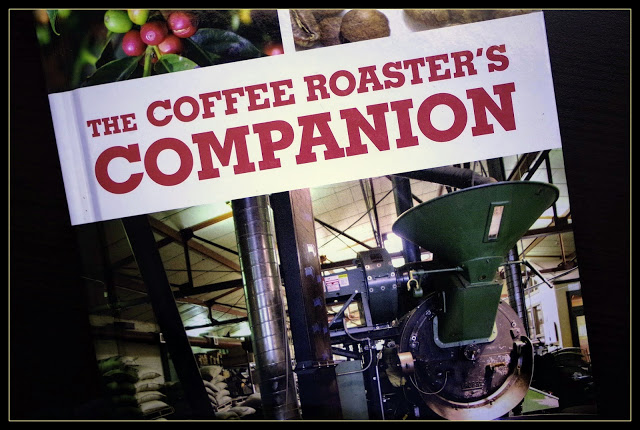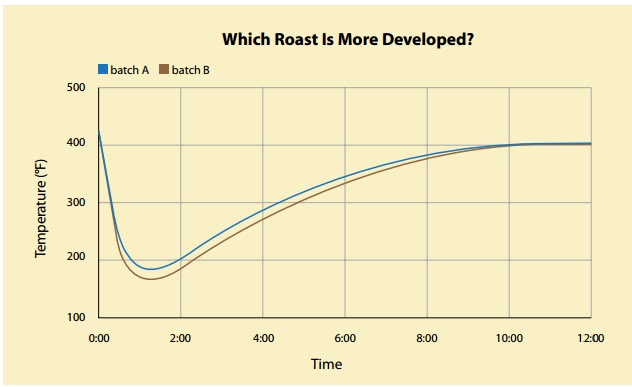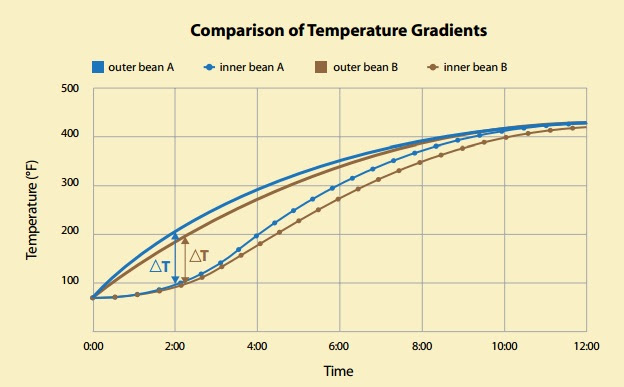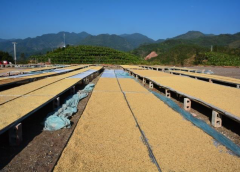Three laws of coffee roasting | interpretation of the baking principles of master roaster Scott Rao

Professional coffee knowledge exchange more coffee bean information please follow the coffee workshop (Wechat official account cafe_style)
Scott Rao's The Coffee Roaster's Companion, published in 2014, can't help but burst into a cold sweat after a few years of re-reading it. He thinks he is a believer in his principle of baking beans, but in fact he makes a lot of mistakes in details, and he doesn't know it when there are hints in the book.
The following is the tenth chapter of this book, an excerpt of baked beans and my own thoughts.
1. At the beginning of baking, sufficient heat energy should be provided (the attached picture is intercepted from pdf)

As shown in the picture above, the temperature recovery point of An is higher and the flavor development of An is better than that of B.
My question: is the more firepower the better? does the increase in bean temperature have the same effect?
Now the firepower is getting bigger and bigger, so that when the explosion begins, there will be more room to adjust ROR to avoid flick.
Scott Rao's recent article The Soak changed his mind that the initial firepower should not be too large, avoid the drum temperature is too high, and can improve the development of coffee flavor and increase the room to avoid mistakes.

two。 The rate of temperature rise (ROR) must decrease.
If the ROR is increased, the sweetness will be sacrificed.
If the ROR is horizontal, the sweetness is destroyed and there is a plain, dry cereal, straw or carton flavor.
If ROR drops sharply, the flavor will not develop completely. Unless the beans are dropped immediately, the baked will be produced. If the ROR is 0 or negative, the sweetness will disappear completely, and the baking flavor will dominate the whole flavor.
The reason why temperature loss reduces sweetness and produces baking flavor is due to the developing sugar chain (sugar chains) cross-linking (cross-link) relationship.
The bean baker predicts and adjusts the heat according to the following conditions
If ROR starts to level out 1-2 minutes before the explosion.
During the explosion, the ROR drops sharply due to the cooling of the evaporated water vapor.
After the second explosion or later, ROR will accelerate up again.
My experience: the last three situations are the problems of crash & flick. They just forget what is mentioned in the books for a long time, but get used to it and think that it doesn't have that much impact. It was not until the curve was slightly adjusted last time that the flavor was found to have improved.
3. The first explosion should occur in the range of 75%-80% of the total baking time (development time accounts for 20-25%).
Definition of a burst: when an individual burst sound is heard more than twice.
This ratio is related to the degree of baking, and the best ratio is even in a narrower range.
If it is too much or less, it will produce the smell of baking, or lack of development.
Instead of talking about development time (development time), discuss the proportion of development time DTR (development time ratio).
Large bean dryer (above 10kg) is not subject to this limit, DTR only needs 15%.
This ratio is suitable for the baking degree before the first explosion and the second explosion.
My experience: at present, this part can not be mastered very well, mainly because there is always an obstacle that seems to be calculating mathematics with a set of formulas; for example, DTR is less than 20%, but it is time to get used to playing beans in the past, which is the most tangled at this time.
Later, after using Artisan software, the computer calculates DTR directly, eliminates psychological obstacles, and then overcomes the problem of crash & flick.
Important Notice :
前街咖啡 FrontStreet Coffee has moved to new addredd:
FrontStreet Coffee Address: 315,Donghua East Road,GuangZhou
Tel:020 38364473
- Prev

What's wrong with my caffeic acid? why does coffee turn sour? what is good coffee?
Professional barista communication Please pay attention to coffee workshop (Wechat official account cafe_style) Coffee contains all kinds of acids, most of which can be found in agricultural products: amino acids such as asparagic acid, glutamic acid and leucine; the concentration of amino acids exceeds the normal value, it will produce sweetness. Carbolic acid such as caffeic acid, chlorogenic acid and quinic acid; the concentration of carbolic acid is higher than normal.
- Next

Can you tell a person's personality by drinking coffee? See the characteristics of the producing area from the coffee beans
Communication of professional baristas Please pay attention to Coffee Workshop (Wechat official account cafe_style) there are all kinds of coffee all over the world, each kind of coffee has different taste and flavor ~ the carefully brewed coffee is different from your own preferences, then the best coffee will not feel delicious, so it is important to understand the personality of coffee. The so-called pure coffee means to use a single coffee
Related
- Beginners will see the "Coffee pull flower" guide!
- What is the difference between ice blog purified milk and ordinary milk coffee?
- Why is the Philippines the largest producer of crops in Liberia?
- For coffee extraction, should the fine powder be retained?
- How does extracted espresso fill pressed powder? How much strength does it take to press the powder?
- How to make jasmine cold extract coffee? Is the jasmine + latte good?
- Will this little toy really make the coffee taste better? How does Lily Drip affect coffee extraction?
- Will the action of slapping the filter cup also affect coffee extraction?
- What's the difference between powder-to-water ratio and powder-to-liquid ratio?
- What is the Ethiopian local species? What does it have to do with Heirloom native species?

